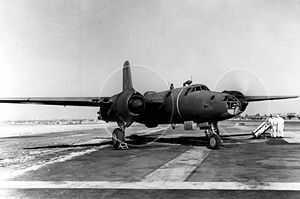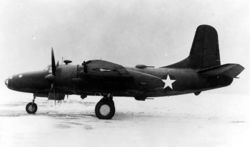- North American XB-28
-
XB-28 North American XB-28 with engines running. Role High-altitude medium bomber Manufacturer North American Aviation Status Prototype Primary user U.S. Army Air Force Number built 2 Developed from B-25 Mitchell The North American XB-28 (NA-63) was an aircraft proposed by the North American Aviation to fill a strong need in the United States Army Air Corps for a high-altitude medium bomber. It never entered into full production, with only two aircraft having been built.
Contents
Design and development
The order for a high-altitude medium bomber was put out on 13 February 1940; the XB-28 first flew on 26 April 1942. The XB-28 was based on North American Aviation's highly successful B-25 Mitchell, but as it evolved it became a completely new design, much more reminiscent of the Martin B-26 Marauder. The overall configuration of the B-25 and XB-28 were fairly similar; the most important distinction was that the twin tail of the B-25 was changed to a single tail on the XB-28. It was among the first planes with a pressurised cabin.
The XB-28 proved an excellent design, with significantly better performance than the B-25, but it was never put into production. High-altitude bombing was hampered significantly by factors such as clouds and wind, which were frequent occurrences in the Pacific. At the same time, medium bombers were becoming much more able at lower altitudes. The models being used at these levels had been used successfully in combat for months and even years. The gains in aircraft performance that came with high altitude flight were not significant enough to justify switching from low-altitude bombing.
Testing and evaluation
Even though the Army Air Forces rejected the XB-28 as a bomber, they ordered another prototype. Designated XB-28A, it was meant to explore the possibility of use as a reconnaissance aircraft. This design never progressed past the prototype stage either. The XB-28A crashed into the Pacific off Southern California after crew bail-out on 4 August 1943.[1]
Specifications (XB-28A)
Data from[citation needed]
General characteristics
- Crew: five
- Length: 56 ft 5 in (17.20 m)
- Wingspan: 72 ft 7 in (22.12 m)
- Height: 14 ft 0 in (4.27 m)
- Wing area: 676 ft² (62.8 m²)
- Empty weight: 25,575 lb (11,600 kg)
- Loaded weight: 35,740 lb (16,210 kg)
- Max takeoff weight: 37,200 lb (16,874 kg)
- Powerplant: 2 × Pratt & Whitney R-2800-27 turbosupercharged radial engines, 2,000 hp (1,500 kW) each
Performance
- Maximum speed: 372 mph (599 km/h) at 25,000 ft (7,600 m)
- Cruise speed: 255 mph (410 km/h)
- Range: 2,040 mi (3,280 km)
- Service ceiling: 33,500 ft (10,213 m)
- Rate of climb: 1,111 ft/min (6 m/s)
- Wing loading: 52.87 lb/ft² (258.14 kg/m²)
- Power/mass: 0.112 hp/lb (184 W/kg)
Armament
- Guns: 6 × .50 in (12.7 mm) machine guns in remote-sighted turrets
- Bombs: 4,000 lb (1,814 kg)
See also
- Related development
- Aircraft of comparable role, configuration and era
- Related lists
References
- Notes
- ^ Dean, Jack, "The Charge Of The Light Brigade", Airpower, Granada Hills, California, November 1998, Volume 28, Number 6, page 39.
- Bibliography
External links
USAAS/USAAC/USAAF/USAF bomber designations 1924–1962 Bomber XB-1 · B-2 · B-3 · B-4 · B-5 · B-6 · Y1B-7 · XB-8 · YB-9 · B-10 · YB-11 · B-12 · XB-13 · XB-14 · XB-15 · XB-16 · B-17 · B-18 · XB-19 · Y1B-20 · XB-21 · XB-22 · B-23 · B-24 · B-25 · B-26 · XB-27 · XB-28 · B-29 · XB-30 · XB-31 · B-32 · XB-33 · B-34 · YB-35 · B-36 · B-37 · XB-38 · XB-39 · YB-40 · XB-41 · XB-42 · XB-43 · XB-44 · B-45 · XB-46 · B-47 · XB-48 · YB-49 · B-50 · XB-51 · B-52 · XB-53 · B-54 · XB-55 · XB-56 · B-57 · B-58 · XB-59 · YB-60 · B-61 · B-62 · B-63 · B-64 · B-65 · B-66 · B-67 · XB-68/SM-68 · RB-69 · XB-70 · SR-71
Light bomber Heavy bomber XHB-1 · XHB-2 · XHB-3
Long-range bomber Lists relating to aviation General Aircraft (manufacturers) · Aircraft engines (manufacturers) · Airlines (defunct) · Airports · Civil authorities · Museums · Registration prefixes · Rotorcraft (manufacturers) · TimelineMilitary Accidents/incidents Records Categories:- United States bomber aircraft 1940–1949
- North American Aviation aircraft
- Twin-engined aircraft
Wikimedia Foundation. 2010.


